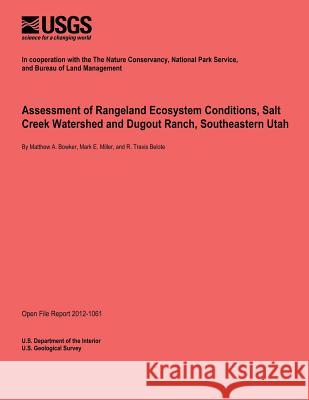Assessment of Rangeland Ecosystem Conditions, Salt Creek Watershed and Dugout Ranch, Southeastern Utah » książka
Assessment of Rangeland Ecosystem Conditions, Salt Creek Watershed and Dugout Ranch, Southeastern Utah
ISBN-13: 9781495960994 / Angielski / Miękka / 2014 / 64 str.
Assessment of Rangeland Ecosystem Conditions, Salt Creek Watershed and Dugout Ranch, Southeastern Utah
ISBN-13: 9781495960994 / Angielski / Miękka / 2014 / 64 str.
(netto: 64,58 VAT: 5%)
Najniższa cena z 30 dni: 67,62
ok. 16-18 dni roboczych
Dostawa w 2026 r.
Darmowa dostawa!
Increasingly, dry rangelands are being valued for multiple services beyond their traditional value as a forage production system. Additional ecosystem services include the potential to store carbon in the soil and plant biomass. In addition, dust emissions from rangelands might be considered an ecosystem detriment, the opposite of an ecosystem service. Dust emitted may have far-reaching impacts, for example, reduction of local air quality, as well as altering regional water supplies through effects on snowpack. Using an extensive rangeland monitoring dataset in the greater Canyonlands region (Utah, USA), we developed a method to estimate indices of the provisioning of three ecosystem services (forage production, dust retention, C storage) and one ecosystem property (nativeness), taking into account both ecosystem type and alternative states within that ecosystem type. We also integrated these four indices into a multifunctionality index. Comparing the currently ungrazed Canyonlands National Park watersheds to the adjacent Dugout Ranch pastures, we found clearly higher multifunctionality was attained in the Park, and that this was primarily driven by greater C-storage and better dust retention. It is unlikely to maximize all benefits and minimize all detriments at the same time. Some goods and services may have synergistic interactions; for example, managing for carbon storage will increase plant and biocrust cover likely lowering dust emission. Likewise, some may have antagonistic interactions. For instance, if carbon is consumed as biomass for livestock production, then carbon storage may be reduced. Ultimately our goal should be to quantify the monetary consequences of specific land use practices for multiple ecosystem services and determine the best land use and adaptive management practices for attaining multiple ecosystem services, minimizing economic detriments, and maximizing economic benefits from multi-commodity rangelands. Our technique is the first step toward this goal, allowing the simultaneous consideration of multiple targeted ecosystem services and properties.
Zawartość książki może nie spełniać oczekiwań – reklamacje nie obejmują treści, która mogła nie być redakcyjnie ani merytorycznie opracowana.











